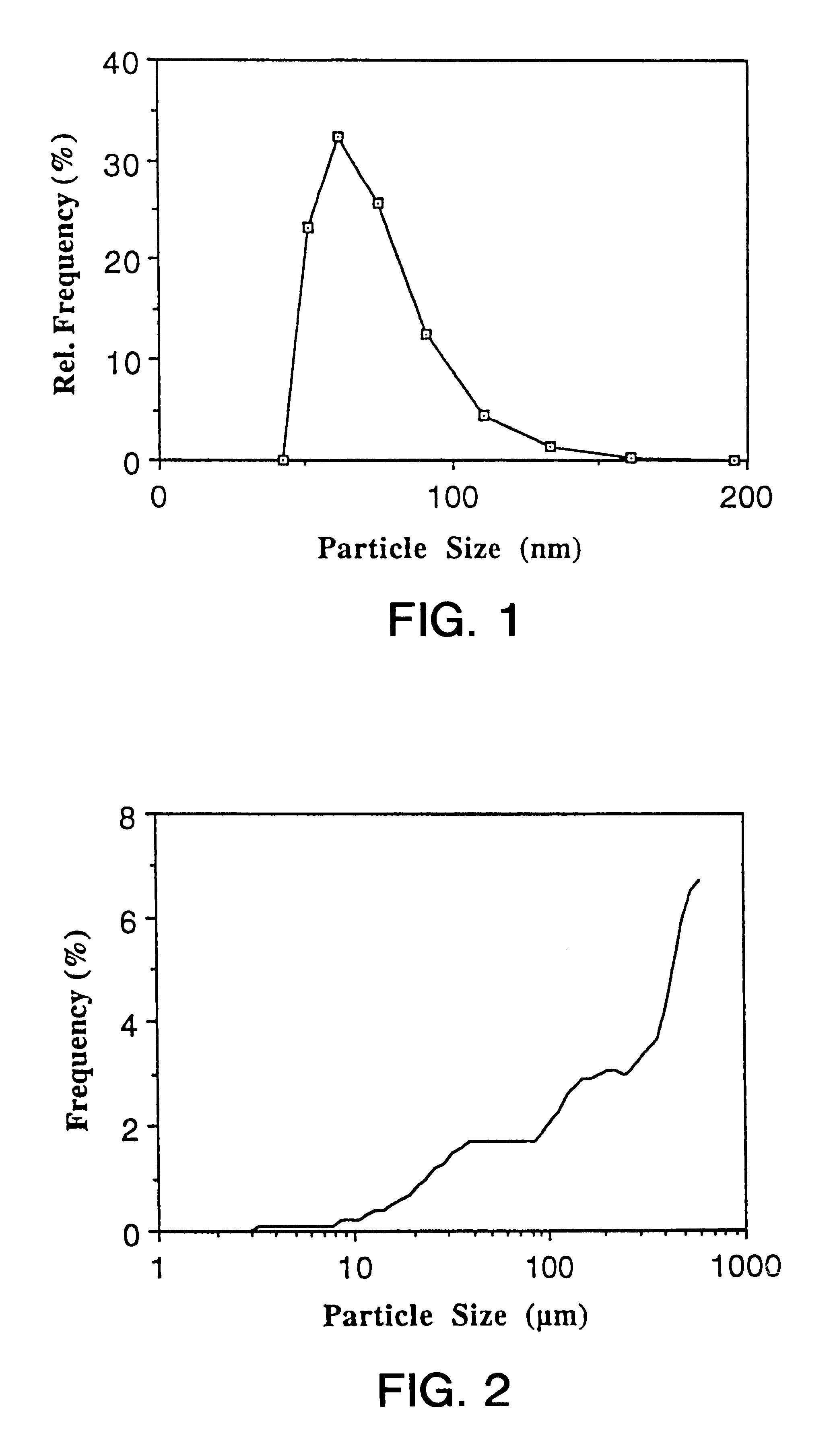Particles with modified physicochemical properties, their preparation and uses
- Summary
- Abstract
- Description
- Claims
- Application Information
AI Technical Summary
Benefits of technology
Problems solved by technology
Method used
Image
Examples
example 1
3.0 g ubidecarenone is melted in a thermostatized vessel at 70.degree. C. 1.8 g lecithin (Phospholipon 100. Nattermann) is dispersed in the melt by sonication (Soniprep, MSE). 95.2 g bidistilled water heated to 70.degree. C. is added to the dispersion of lecithin in molten ubidecarenone. The warm mixture is predispersed by high speed vortexing (Ultra Turrax) for 120 sec. The predispersion is homogenized at 900 bar for 10 min in a high pressure homogenizer type Microfluidizer (Microfluidics Corp.) which is immersed in a water bath heated to 70.degree. C. The dispersion is allowed to stand at room temperature for cooling.
The mean particle size (number distribution) of the dispersion is determined by photon correlation spectroscopy (PCS: Zetasizer 3, Malvern) to be 102.5 nm.
example 2
3.0 g ubidecarenone is melted in a thermostatized vessel at 70.degree. C. 1.5 g lecithin (Phospholipon 100, Nattermann) is dispersed in the melt by sonication (Soniprep. MSE). 300 mg sodium glycocholate is dissolved in 95.2 g bidistilled water, and the solution is heated to 70.degree. C. The heated aqueous phase is added to the dispersion of lecithin in molten ubidecarenone. The warm mixture is predispersed by high speed vortexing (Ultra Turrax) for 120 sec. The predispersion is homogenized at 900 bar for 10 min in a high pressure homogenizer type Microfluidizer (Microfluidics Corp.) which is immersed in a water bath heated to 70.degree. C. The dispersion is allowed to stand at room temperature for cooling.
The mean particle size (number distribution) of the dispersion determined by PCS is 68.5 nm. Ubidecarenone nanoparticles display a narrow particle size distribution (FIG. 1). For comparison, FIG. 2 illustrates the particle size distribution of the powdered raw material of ubidecar...
example 3
In order to estimate the stability on storage of the aqueous dispersions of ubidecarenone prepared according to Example 1 and 2, the particle size of the dispersions stored at 4.degree. C. was repeatedly determined by PCS at different time intervals over a monitored period of 30 months. FIG. 3 presents the mean particle size of ubidecarenone nanoparticles of Example 1 and 2 versus storage time. The mean particle is practically constant over the monitored period of 30 months. Ubidecarenone nanoparticles thus exhibit an excellent stability on storage.
PUM
| Property | Measurement | Unit |
|---|---|---|
| Angle | aaaaa | aaaaa |
| Particle size | aaaaa | aaaaa |
| Particle size | aaaaa | aaaaa |
Abstract
Description
Claims
Application Information
 Login to View More
Login to View More - R&D
- Intellectual Property
- Life Sciences
- Materials
- Tech Scout
- Unparalleled Data Quality
- Higher Quality Content
- 60% Fewer Hallucinations
Browse by: Latest US Patents, China's latest patents, Technical Efficacy Thesaurus, Application Domain, Technology Topic, Popular Technical Reports.
© 2025 PatSnap. All rights reserved.Legal|Privacy policy|Modern Slavery Act Transparency Statement|Sitemap|About US| Contact US: help@patsnap.com



